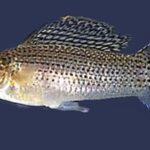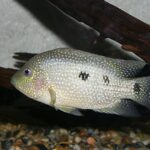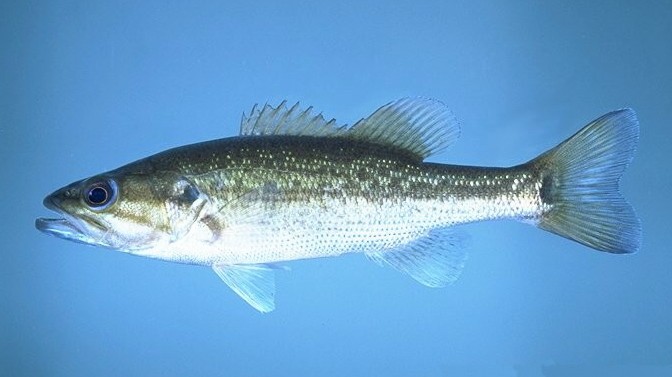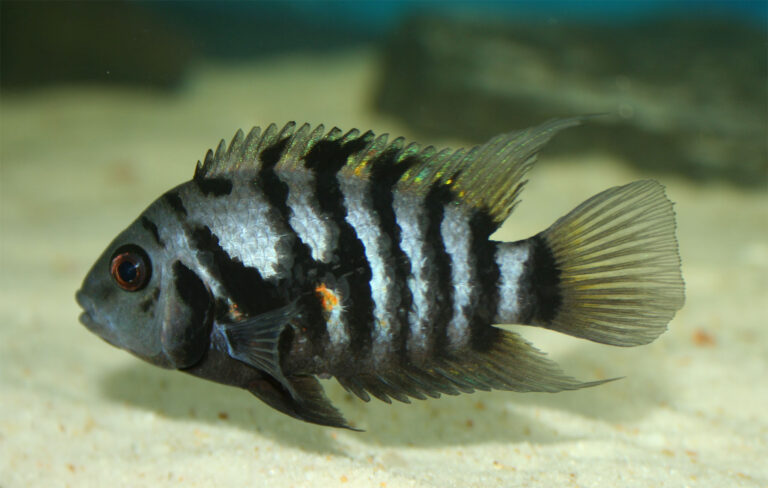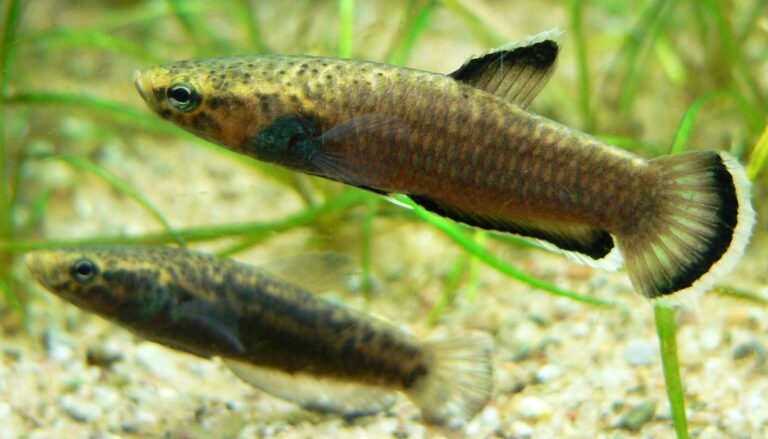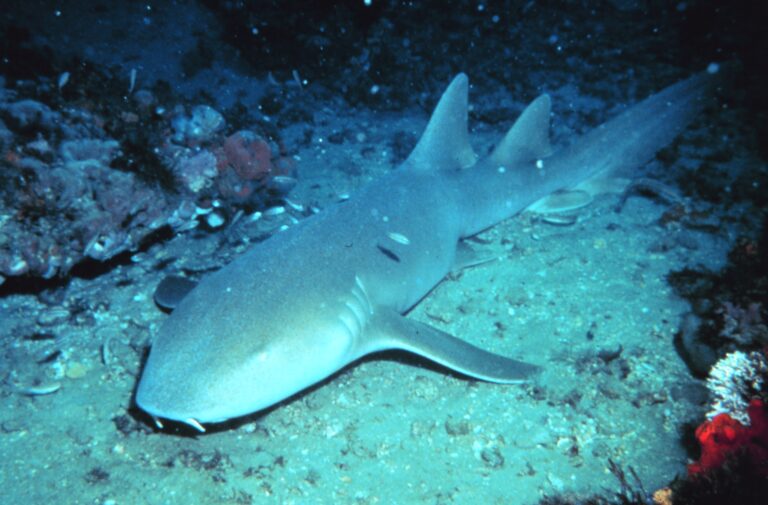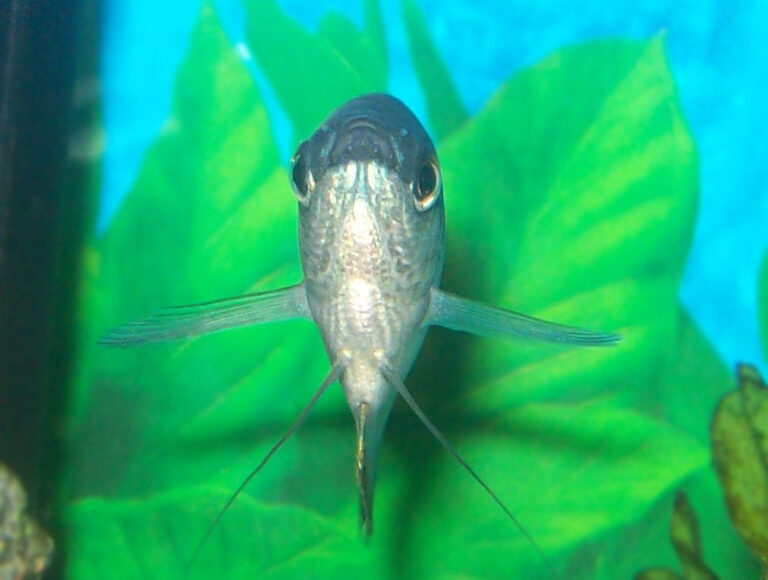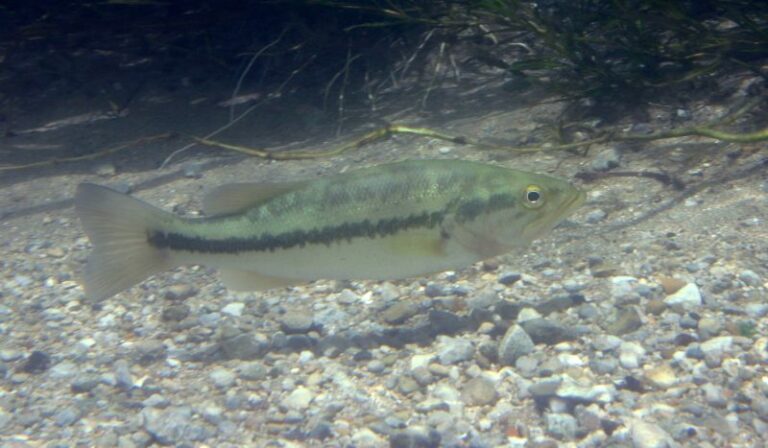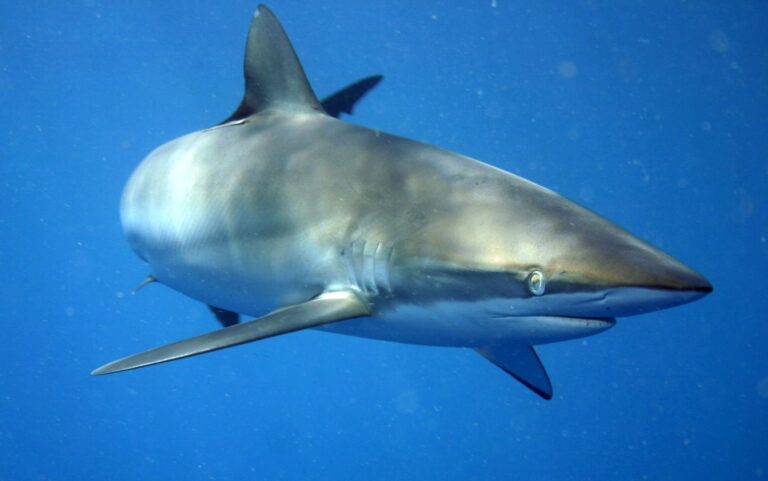Bull Shark
By Ryan Maron | Last Modified: July 5, 2025
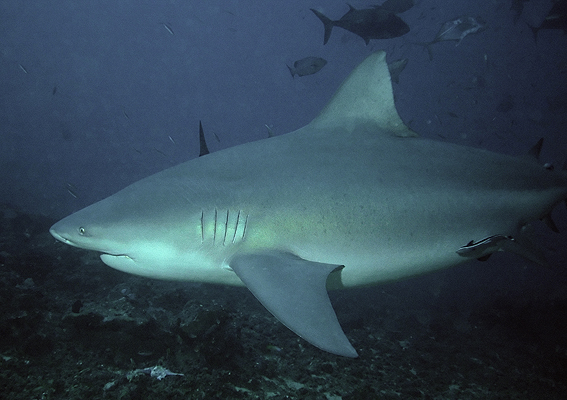
The Bull Shark represents one of the most formidable apex predators in marine ecosystems worldwide. Known scientifically as Carcharhinus leucas, this remarkable species has earned its reputation through both its aggressive hunting behavior and its extraordinary ability to survive in both saltwater and freshwater environments. Unlike most sharks that remain confined to marine waters, the Bull Shark demonstrates remarkable physiological adaptations that allow it to penetrate far inland through river systems, making it one of the most widely distributed large predatory fish species on Earth.
The ecological significance of the Bull Shark cannot be overstated. As a top predator, this species plays a crucial role in maintaining the balance of marine food webs by controlling populations of mid-level predators and prey species. Their presence in both coastal and inland waters creates a unique ecological bridge between marine and freshwater systems, influencing fish populations across multiple habitats. Economically, Bull Sharks contribute to recreational fishing industries and marine tourism, while their presence in popular swimming areas has led to important research into shark behavior and human-shark interactions.
| Feature | Details |
|---|---|
| Common Name | Bull Shark |
| Scientific Name | Carcharhinus leucas |
| Family | Carcharhinidae |
| Typical Size | 240-340 cm (8-11 ft), 130-230 kg (290-500 lbs) |
| Habitat | Coastal waters, rivers, estuaries |
| Diet | Opportunistic carnivore |
| Distribution | Tropical and subtropical waters worldwide |
| Conservation Status | Vulnerable |
Taxonomy & Classification
The Bull Shark belongs to the family Carcharhinidae, commonly known as requiem sharks, which encompasses over 60 species of medium to large sharks found in warm seas worldwide. Within this diverse family, Carcharhinus leucas holds a distinctive position due to its unique physiological adaptations and behavioral characteristics. The genus Carcharhinus, established by Blainville in 1816, includes approximately 35 species of sharks that share similar morphological features and ecological niches.
The species was first scientifically described by Valenciennes in 1839, though the taxonomic history of the Bull Shark includes several synonyms and regional variations in naming conventions. The specific epithet “leucas” derives from the Greek word meaning “white,” referring to the pale coloration of the shark’s underside. This binomial nomenclature reflects the species’ characteristic countershading pattern, which serves as an important identification feature.
Phylogenetic analyses have revealed that Bull Sharks are most closely related to other large Carcharhinus species, including the Copper Shark and Blacktip Shark. Recent molecular studies suggest that the Bull Shark lineage diverged from its closest relatives approximately 15-20 million years ago during the Miocene epoch. This evolutionary timeline corresponds with significant changes in global ocean circulation patterns and the expansion of coastal environments that would have favored the development of euryhaline capabilities.
The taxonomic classification places the Bull Shark within the superorder Selachimorpha, which encompasses all modern sharks. This positioning reflects shared anatomical features such as cartilaginous skeletons, multiple gill slits, and specialized dentition patterns that distinguish sharks from other fish groups.
Physical Description
The Bull Shark exhibits a robust, stocky build that immediately distinguishes it from other shark species. Adult specimens typically measure between 240-340 centimeters in total length, with females generally achieving larger sizes than males. The body shape is characterized by a broad, flattened head and a thick, muscular trunk that tapers toward a powerful heterocercal tail. This morphology provides the hydrodynamic efficiency necessary for both burst swimming and sustained cruising in various aquatic environments.
The head structure represents one of the most distinctive features of the Bull Shark. The snout is notably short and blunt, giving the species its common name and creating a characteristic profile that differs markedly from the more pointed snouts of related species. The eyes are small relative to body size and positioned laterally on the head, providing a wide field of vision essential for detecting prey and potential threats. The mouth extends well beyond the eye level and contains multiple rows of triangular, serrated teeth designed for cutting through flesh and bone.
Coloration follows a typical countershading pattern, with the dorsal surface ranging from dark gray to brown, gradually transitioning to white or pale yellow on the ventral surface. This coloration pattern provides camouflage in both pelagic and benthic environments, making the shark less visible to both prey and predators. Some individuals display subtle variations in coloration intensity, particularly in turbid river environments where darker pigmentation may provide additional camouflage advantages.
The fin structure includes two dorsal fins, with the first being significantly larger and positioned roughly at the midpoint of the body. The pectoral fins are broad and triangular, providing stability during slow-speed maneuvering in shallow waters. The caudal fin exhibits the typical shark heterocercal structure, with the upper lobe being notably larger than the lower lobe, generating the thrust necessary for rapid acceleration during hunting sequences.
Habitat & Distribution
Bull Sharks demonstrate one of the most remarkable habitat ranges among large shark species, occupying tropical and subtropical waters across the globe. Their distribution spans the Atlantic, Pacific, and Indian Oceans, with populations established along continental coastlines between approximately 40° North and 40° South latitude. This extensive range reflects the species’ exceptional adaptability to varying environmental conditions and salinity levels.
The most extraordinary aspect of Bull Shark habitat utilization is their ability to penetrate deep into freshwater river systems. Unlike most marine sharks that cannot survive in freshwater due to osmotic stress, Bull Sharks possess specialized physiological adaptations that allow them to regulate their internal salt concentration. This capability has enabled them to travel hundreds of kilometers upstream in major river systems, including the Mississippi River in North America, the Amazon River in South America, and the Zambezi River in Africa.
Coastal habitats represent the primary environment for Bull Shark populations, with individuals commonly found in shallow bays, estuaries, and nearshore waters. These areas provide abundant prey resources and serve as important nursery grounds for juvenile sharks. Water depths typically range from 1-30 meters, though individuals have been recorded in waters exceeding 150 meters depth during seasonal migrations.
Estuarine environments hold particular significance for Bull Shark ecology, as these transitional zones between marine and freshwater systems offer optimal conditions for feeding and reproduction. The mixing of salt and fresh water creates unique chemical gradients that concentrate nutrients and support diverse prey communities. Additionally, the turbid waters common in estuarine systems provide visual cover that enhances hunting success rates.
Temperature preferences generally range between 20-30°C, with populations showing seasonal movement patterns that correspond to thermal fluctuations. In temperate regions, Bull Sharks typically migrate toward warmer waters during winter months, while tropical populations may exhibit more localized movement patterns based on prey availability and reproductive cycles.
Diet & Feeding Behavior
The Bull Shark exhibits opportunistic feeding behavior characterized by an exceptionally diverse diet that reflects its wide-ranging habitat preferences. As apex predators, these sharks consume a broad spectrum of prey items, ranging from small fish and crustaceans to large marine mammals. This dietary flexibility contributes significantly to their success across various aquatic environments and establishes them as keystone species in multiple ecosystems.
Bony fish constitute the primary component of Bull Shark diets, with species composition varying according to geographic location and seasonal availability. Common prey items include tarpon, mullet, catfish, and various members of the drum family. In freshwater environments, Bull Sharks readily consume river fish species such as gar, buffalo fish, and various sunfish species. The transition between marine and freshwater prey demonstrates the remarkable adaptability of their feeding strategies.
Elasmobranchs, including smaller shark species and rays, represent another significant dietary component. Bull Sharks frequently prey upon juvenile sharks of their own species as well as other Carcharhinus species, blacktip sharks, and various ray species. This intraspecific and interspecific predation plays an important role in regulating local predator populations and maintaining ecosystem balance.
Crustaceans, particularly large crabs and lobsters, provide important nutritional resources, especially for juvenile Bull Sharks. The powerful jaw muscles and specialized dentition allow these predators to crush the hard exoskeletons of crustacean prey effectively. In shallow coastal waters, blue crabs and mud crabs often comprise substantial portions of the diet.
Marine mammals occasionally fall prey to large Bull Sharks, with documented cases of predation on dolphins, seals, and even small whales. These interactions typically occur in deeper coastal waters where both predator and prey species overlap in their habitat utilization patterns. The hunting strategy for large prey often involves ambush tactics, utilizing the shark’s ability to remain motionless near the bottom before launching powerful upward attacks.
Feeding behavior varies according to prey type and environmental conditions. In turbid waters, Bull Sharks rely heavily on electroreception and lateral line systems to detect prey, while in clearer waters, visual hunting becomes more prominent. The species exhibits both solitary and group feeding behaviors, with aggregations sometimes forming around abundant food sources such as fish spawning areas or marine mammal carcasses.
Behavior & Adaptations
Bull Sharks exhibit complex behavioral patterns that reflect their status as highly successful apex predators. Their behavioral repertoire includes sophisticated hunting strategies, territorial displays, and remarkable physiological adaptations that enable survival across diverse aquatic environments. These behaviors have evolved over millions of years to optimize survival and reproductive success in challenging ecological niches.
The most remarkable adaptation of Bull Sharks is their ability to regulate internal salt concentrations when transitioning between marine and freshwater environments. This osmoregulatory capability involves specialized kidney function, modified gill structures, and behavioral adjustments that allow gradual acclimation to changing salinity levels. The process typically requires several days to weeks, during which sharks may remain in brackish transition zones to facilitate physiological adjustments.
Territorial behavior becomes particularly pronounced during breeding seasons and in areas with high prey density. Adult Bull Sharks establish temporary territories around productive feeding areas, defending these spaces through aggressive displays and direct confrontation with conspecifics. These territorial disputes often involve circling behaviors, where competing individuals swim in tight circles while displaying their size and strength.
Hunting strategies vary significantly based on prey type and environmental conditions. In shallow waters, Bull Sharks often employ ambush tactics, remaining motionless near the bottom before launching surprise attacks on unsuspecting prey. This behavior is particularly effective in turbid waters where visual detection is limited. In contrast, open-water hunting involves more active pursuit strategies, with sharks using their powerful swimming abilities to chase down fast-moving prey.
Social behavior in Bull Sharks remains relatively limited compared to some other shark species, though temporary aggregations occur around abundant food sources or during seasonal migrations. These gatherings typically involve loose associations rather than structured social hierarchies, with individuals maintaining spacing that minimizes direct competition while maximizing foraging efficiency.
The species demonstrates remarkable learning capabilities, with individuals showing evidence of spatial memory and recognition of productive feeding areas. This cognitive ability contributes to their success in complex environments where prey distribution patterns change seasonally or in response to environmental variables. Such behavioral flexibility represents a key adaptation that has enabled Bull Sharks to colonize diverse habitats successfully.
Reproduction & Life Cycle
Bull Shark reproduction follows a viviparous strategy characterized by internal fertilization and live birth of fully developed young. The reproductive cycle spans multiple years, with females typically reaching sexual maturity at 175-235 centimeters in length, corresponding to ages of 10-15 years. Males mature earlier, generally achieving reproductive capability at 160-210 centimeters and 8-10 years of age.
Mating behavior occurs primarily in shallow coastal waters and estuarine environments during warmer months. Courtship involves complex behavioral displays where males pursue females through shallow areas, often in waters less than 3 meters deep. The actual mating process involves the male grasping the female’s pectoral fin with his teeth while inserting one of his claspers into the female’s cloaca. This behavior can result in significant scarring on females, which serves as an indicator of reproductive activity.
Gestation periods extend approximately 10-11 months, during which embryos develop within the female’s uterus. The reproductive strategy includes a form of intrauterine cannibalism where larger, more developed embryos consume smaller siblings and unfertilized eggs. This phenomenon, known as adelphophagy, ensures that only the strongest offspring survive to birth, though it significantly reduces litter sizes.
Litter sizes typically range from 1-13 pups, with an average of 4-10 offspring per reproductive cycle. Newborn Bull Sharks measure approximately 56-81 centimeters at birth and are immediately capable of independent survival. The large size at birth provides significant advantages in avoiding predation and competing for food resources in nursery habitats.
Nursery areas are typically located in shallow, protected waters such as estuaries, mangrove creeks, and river mouths. These environments provide abundant food resources and offer protection from larger predators that might prey upon juvenile sharks. The warm, nutrient-rich waters support rapid growth rates, with young sharks potentially doubling their length within the first year of life.
Reproductive cycles are not annual, with females typically producing offspring every 2-3 years. This extended reproductive interval allows females to recover from the energetic demands of gestation and ensures optimal condition for subsequent reproductive efforts. The combination of late maturation, extended gestation, and infrequent reproduction makes Bull Shark populations particularly vulnerable to overfishing and habitat degradation.
Predators & Threats
Adult Bull Sharks face relatively few natural predators due to their large size and aggressive nature, though several species pose potential threats throughout their life cycle. Large crocodilians, including American alligators and saltwater crocodiles, represent significant predators in estuarine and freshwater environments where their ranges overlap with Bull Shark populations. These encounters typically occur in shallow waters where both species hunt for similar prey items.
Other large shark species, including Tiger Sharks and Great White Sharks, occasionally prey upon Bull Sharks, particularly juveniles and smaller adults. These interactions usually occur in deeper coastal waters where multiple large predator species converge around abundant food sources. The outcome of such encounters depends largely on the relative size and condition of the individual sharks involved.
Juvenile Bull Sharks face a broader range of predators, including various fish species, marine mammals, and birds. Large groupers, tarpon, and other predatory fish species readily consume young Bull Sharks in nursery habitats. Marine mammals such as dolphins may also prey upon juveniles, though such interactions are less frequently documented.
Human activities represent the most significant threat to Bull Shark populations worldwide. Commercial and recreational fishing operations target Bull Sharks for their meat, fins, and liver oil, with demand for shark fin soup in Asian markets driving intensive fishing pressure. The species’ tendency to inhabit shallow coastal waters makes them particularly vulnerable to fishing activities and habitat modification.
Habitat degradation poses an increasingly serious threat to Bull Shark populations. Coastal development, pollution, and dam construction along river systems directly impact critical nursery habitats and feeding areas. The destruction of mangrove forests and estuarine wetlands eliminates essential breeding and juvenile development areas, while chemical pollution can affect reproductive success and survival rates.
Climate change presents emerging challenges for Bull Shark populations through rising sea temperatures, changing precipitation patterns, and sea level rise. These environmental changes may alter prey distribution patterns, affect the salinity gradients that Bull Sharks depend upon for osmoregulation, and potentially eliminate some freshwater habitats entirely.
Boat strikes represent another human-related threat, particularly in heavily trafficked waterways where Bull Sharks are known to occur. The species’ tendency to inhabit shallow waters increases the likelihood of encounters with recreational and commercial vessels, potentially resulting in injuries or mortality.
Conservation Status
The International Union for Conservation of Nature (IUCN) currently classifies the Bull Shark as Vulnerable on the Red List of Threatened Species. This designation reflects declining population trends observed across much of the species’ range, primarily due to fishing pressure and habitat degradation. The assessment indicates that Bull Shark populations have experienced significant reductions over the past several decades, with some regional populations showing particularly steep declines.
Regional assessments reveal varying conservation statuses across different parts of the Bull Shark’s range. In the western Atlantic, populations appear to be more stable compared to those in the Indo-Pacific region, where intensive fishing pressure has resulted in more severe population declines. The Mediterranean Sea population is considered particularly vulnerable due to limited habitat availability and high fishing pressure.
Several countries have implemented protective measures for Bull Shark populations, though enforcement and effectiveness vary considerably. The United States has established seasonal fishing closures and size limits for Bull Sharks in federal waters, while some states have implemented additional protective measures in state waters. Australia has included Bull Sharks in various fisheries management plans, though recreational fishing continues in many areas.
International trade in Bull Shark products is regulated under the Convention on International Trade in Endangered Species of Wild Fauna and Flora (CITES), which requires permits for international trade in shark fins and other products. However, enforcement of these regulations remains challenging, particularly in developing countries where monitoring capabilities are limited.
Research efforts have increased significantly in recent years, with scientists using satellite tracking, genetic analysis, and population modeling to better understand Bull Shark biology and population dynamics. These studies provide essential information for developing effective conservation strategies and assessing the success of protective measures.
The establishment of marine protected areas has shown promise for Bull Shark conservation, particularly when these areas encompass critical nursery habitats and feeding areas. However, the wide-ranging nature of Bull Sharks means that effective conservation requires coordinated efforts across multiple jurisdictions and habitat types.
Public education and awareness campaigns have helped reduce demand for shark products in some regions, though continued efforts are needed to address the cultural and economic factors that drive shark fishing. The development of sustainable fishing practices and alternative livelihoods for fishing communities represents an important component of comprehensive conservation strategies.
Human Interaction
Bull Sharks hold a complex position in human-shark interactions, being simultaneously feared as dangerous predators and valued as important components of marine ecosystems. Their reputation as aggressive sharks stems from their involvement in unprovoked attacks on humans, with Bull Sharks ranking among the top three species responsible for shark bite incidents worldwide. This reputation has significantly influenced public perception and management policies concerning the species.
The majority of Bull Shark encounters with humans occur in shallow coastal waters, river mouths, and estuarine environments where recreational activities such as swimming, surfing, and fishing are common. The species’ tolerance for turbid water and ability to enter freshwater systems brings them into contact with humans in areas where shark encounters are unexpected. These interactions are typically brief and non-aggressive, though the potential for mistaken identity attacks exists, particularly in low-visibility conditions.
Recreational fishing for Bull Sharks has grown in popularity, with the species being targeted for sport fishing opportunities. The powerful fighting ability and large size of Bull Sharks make them prized catches among anglers, though increasing conservation awareness has led to greater adoption of catch-and-release practices. Fishing tournaments and charter operations in coastal areas often feature Bull Shark fishing as a primary attraction.
Commercial fishing operations have historically targeted Bull Sharks for their meat, liver oil, and fins. The meat is considered good quality and is marketed both locally and internationally, while the fins command high prices in Asian markets. The liver oil has been used in various industrial applications, though synthetic alternatives have reduced demand in recent years.
The development of shark tourism has created new economic opportunities in regions where Bull Sharks are common. Dive operations and eco-tourism companies offer guided experiences to observe Bull Sharks in their natural habitats, providing alternative revenue sources for coastal communities. These activities require careful management to ensure both human safety and minimal impact on shark behavior.
Beach safety programs and shark bite prevention initiatives have been implemented in areas where Bull Sharks are known to occur frequently. These programs typically include public education about shark behavior, establishment of shark spotting networks, and development of emergency response protocols. The effectiveness of these programs depends heavily on public cooperation and understanding of shark ecology.
Research collaboration between scientists and fishing communities has improved understanding of Bull Shark biology and behavior. Fishers often provide valuable information about shark distribution patterns, seasonal movements, and population changes that contribute to scientific knowledge and conservation planning. Tag-and-release programs have been particularly successful in engaging recreational fishers in scientific research efforts.
Interesting Facts
The Bull Shark’s ability to survive in freshwater environments has led to several remarkable discoveries, including populations that have established themselves in landlocked water bodies. Lake Nicaragua in Central America hosts a population of Bull Sharks that was historically thought to be a separate species before genetic analysis revealed their connection to marine populations. These sharks travel between the lake and the Caribbean Sea via the San Juan River, demonstrating their extraordinary adaptability.
The species exhibits one of the strongest bite forces among sharks, with adult Bull Sharks capable of generating bite forces exceeding 5,900 newtons. This incredible power allows them to crush the shells of large crustaceans and penetrate the thick hides of marine mammals. The bite force is generated by massive jaw muscles that can constitute up to 12% of the shark’s total body weight.
Bull Sharks demonstrate remarkable longevity, with some individuals estimated to live over 30 years in the wild. Age determination studies using vertebral growth rings have revealed that growth rates vary significantly between populations, with sharks in warmer waters generally growing faster than those in cooler climates. This longevity contributes to their vulnerability to overfishing, as populations recover slowly from depletion.
The species’ electroreception capabilities are particularly well-developed, allowing them to detect electrical fields as weak as 0.005 microvolts per centimeter. This sensitivity enables Bull Sharks to locate prey buried in sediment or hiding in murky water where visual detection is impossible. The electroreceptive organs, known as ampullae of Lorenzini, are most concentrated around the head and snout region.
Behavioral studies have revealed that Bull Sharks can recognize and remember individual locations, returning to productive feeding areas with remarkable accuracy. This spatial memory capability has been documented through tagging studies that show individuals returning to the same river systems or coastal areas after months or years of absence. Such behavior suggests more complex cognitive abilities than previously attributed to sharks.
The species plays important roles in various cultural traditions and folklore, particularly among coastal and riverine communities. In some cultures, Bull Sharks are considered sacred animals, while in others, they are viewed as symbols of power and strength. These cultural connections have influenced conservation attitudes and management approaches in different regions.
Recent research has uncovered evidence of tool use behavior in Bull Sharks, with individuals observed using their bodies to stun prey against the substrate. This behavior, while not as sophisticated as tool use in marine mammals, represents an important behavioral adaptation that enhances hunting success in specific environments.
Frequently Asked Questions
Are Bull Sharks more dangerous than other shark species?
Bull Sharks are considered among the most dangerous shark species to humans due to their aggressive nature, powerful bite force, and tendency to inhabit shallow waters where human activities occur. However, unprovoked attacks remain extremely rare, and the species typically avoids human contact when possible. Their reputation for aggression stems from their opportunistic feeding behavior and territorial nature rather than any specific preference for human prey.
How far can Bull Sharks swim up rivers?
Bull Sharks can travel remarkable distances up river systems, with documented cases of individuals swimming over 1,000 kilometers inland. The farthest recorded penetration was in the Mississippi River system, where sharks have been found as far north as Illinois. Their ability to travel such distances depends on river conditions, seasonal water levels, and the presence of barriers such as dams or rapids.
What makes Bull Sharks able to survive in freshwater?
Bull Sharks possess specialized physiological adaptations that allow them to regulate their internal salt concentration when transitioning between saltwater and freshwater environments. Their kidneys can adjust function to retain or excrete salt as needed, while their gills can modify ion transport processes. Additionally, they produce less urea in freshwater to maintain proper cellular function, making them one of the few shark species capable of extended freshwater survival.
How can you identify a Bull Shark from other shark species?
Bull Sharks can be identified by their distinctive short, blunt snout, stocky build, and broad head. They typically display gray to brown coloration on top with lighter undersides. Their first dorsal fin is positioned roughly at the body’s midpoint, and their eyes are relatively small compared to their head size. The combination of these features, along with their habitat preferences for shallow, turbid waters, helps distinguish them from related species such as Blue Sharks which have more slender builds and pointed snouts.
Conclusion
The Bull Shark stands as one of nature’s most successful apex predators, demonstrating remarkable adaptability across marine and freshwater environments. Their unique physiological capabilities, combined with opportunistic feeding strategies and complex behavioral patterns, have enabled them to colonize diverse habitats worldwide. However, increasing human pressures and habitat degradation pose significant challenges to their long-term survival, making continued conservation efforts essential for maintaining healthy populations of this ecologically important species.
Share The Article:
More Fish Species:
-
Wagtail Platy
The Wagtail Platy stands as one of the most distinctive and beloved freshwater aquarium fish, renowned for its elegant…
-
Lionhead Goldfish
The Lionhead Goldfish represents one of the most distinctive and cherished ornamental varieties within the goldfish family, captivating aquarists…
-
Spotted Bass
The Spotted Bass (Micropterus punctulatus) stands as one of North America’s most distinctive freshwater game fish, renowned for its…
-
Firemouth Cichlid
The Firemouth Cichlid (*Thorichthys meeki*) stands as one of Central America’s most recognizable freshwater fish species, distinguished by its…
-
Convict Cichlid
The Convict Cichlid (Amatitlania nigrofasciata) stands as one of the most recognizable and widely distributed freshwater fish species in…
-
Betta Fish
The Betta Fish, scientifically known as Betta splendens, is one of the most visually captivating and widely recognized freshwater…
Discover
-
Louisiana Redfish Fishing: Best Spots & Tactics for Beginners
Finding that first bull red is a moment you never forget. The pull, the power – it’s something special….
-
Steelhead Fishing Guide: Tackle and Tactics for Spring River Runs
There’s something almost magical about standing waist-deep in a frigid spring river, feeling the current push against your legs…
-
Crappie Fishing Guide for Beginners | 2025
Crappie fishing might just be one of the most rewarding experiences for new anglers. These popular panfish are abundant,…
-
Best Fishing Spots in California: Lakes, Rivers, and Coastal Hotspots
California fishing has always struck me as a study in beautiful contradictions. From snow-fed alpine lakes to sweltering desert…
-
Nurse Shark
The Nurse Shark (Ginglymostoma cirratum) stands as one of the most recognizable and ecologically significant bottom-dwelling sharks in tropical…
-
How to Catch Mahi-Mahi: Offshore Tactics That Fill Coolers Fast
I still remember my first encounter with mahi-mahi (also called dolphin fish or dorado). We were about 20 miles…
Discover
-
Blue Gourami
The Blue Gourami (*Trichogaster trichopterus*) stands as one of the most recognizable and adaptable freshwater fish species in tropical…
-
Largemouth Bass
The Largemouth Bass, scientifically known as *Micropterus salmoides*, stands as one of North America’s most iconic freshwater gamefish and…
-
How to Fish with Dry Flies: Beginner’s Guide to Surface Action
There’s something almost magical about watching a trout rise to sip your dry fly from the surface. I still…
-
Croaker Fishing Secrets: Why Most Anglers Miss the Big Ones
Croaker fishing might seem straightforward, but there’s more to catching these tasty fighters than most weekend anglers realize. I’ve…
-
Silky Shark
The Silky Shark represents one of the most widespread and ecologically significant requiem sharks in tropical and subtropical waters…
-
7 Best Fly Fishing Foods That Trout Can’t Resist in 2025
If there’s one thing I’ve learned after three decades of fly fishing, it’s that trout can be maddeningly selective…


